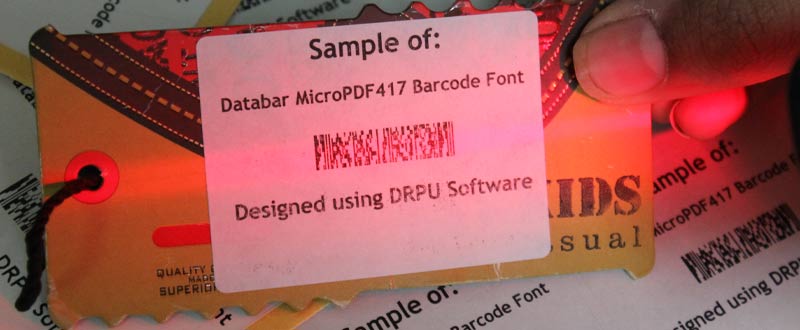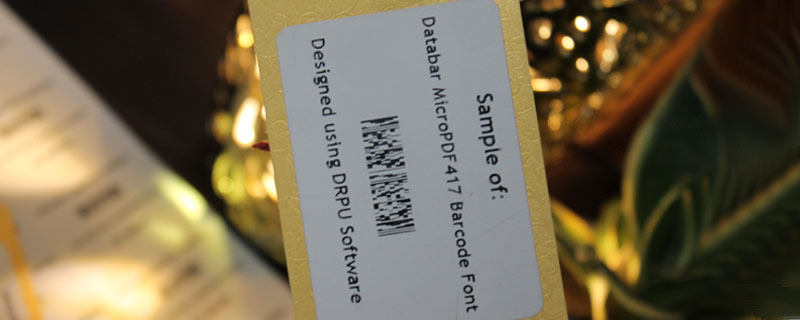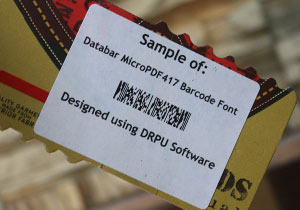Information Encoded in a Databar MicroPDF417 Barcode
A Databar MicroPDF417 barcode can encode a variety of data types, including numeric, alphanumeric, and binary data. It can also encode data in different modes, such as text, byte, numeric, and binary, which enables it to accommodate a wide range of applications. The maximum capacity of a MicroPDF417 barcode is 2500 bytes or 4000 characters, which is significantly more than other 2D barcode symbologies.
The Databar MicroPDF417 barcode is commonly used to encode large amounts of data, such as:-
Shipping and Inventory
Information:
The barcode can store detailed information about a product, including its name, SKU, quantity, weight, and dimensions. This information can be used to track inventory levels and manage the shipping and receiving of products.
-
Medical Records:
The barcode can store information about a patient's medical history, including their name, date of birth, blood type, allergies, and medical conditions. This information can be accessed quickly and easily by healthcare professionals to provide the best possible care to patients.
-
Identification
Cards:
The barcode can store personal information about an individual, including their name, address, date of birth, and identification number. This information can be used to verify the identity of an individual quickly and easily.
-
Ticketing and
Transportation:
The barcode can store information about a ticket or transportation pass, including the date, time, and location of the event or trip. This information can be used to prevent fraud and ensure that the correct ticket or pass is used.
-
Government
Documents:
The barcode can store information about government documents, including passports, driver's licenses, and visas. This information can be used to verify the authenticity of the document and prevent fraud.
Overall, the Databar MicroPDF417 barcode is a versatile symbology that can be used to encode a wide range of data types and is particularly useful for applications that require the storage of large amounts of data in a compact space.
Download and Install Barcode Label Maker
Size of a Databar MicroPDF417 Barcode
The minimum size of a Databar MicroPDF417 barcode is determined by the capabilities of the barcode scanner. The scanner must be able to resolve the individual elements of the barcode, so the X dimension must be large enough to be accurately read by the barcode scanner. The minimum X dimension for a Databar MicroPDF417 barcode is typically around 4 mils, although some scanners may be capable of reading smaller barcodes.
The maximum size of a Databar MicroPDF417 barcode is limited by the size of the object on which it will be printed. In general, the larger the barcode, the easier it is to read with a scanner. However, there may be practical limitations to the size of the barcode, such as the available space on a product label or the size of a shipping container. The maximum size of a Databar MicroPDF417 barcode is typically around 1.5 inches by 1.5 inches.
The size of a Databar MicroPDF417 barcode can also be influenced by the error correction level used in the barcode. Higher levels of error correction require more space in the barcode to encode the same amount of data, so a barcode with a high error correction level will be larger than one with a lower error correction level.
Decode a Databar MicroPDF417 Barcode
Decoding a Databar MicroPDF417 barcode requires a barcode scanner that is capable of reading this particular symbology. Once the scanner has captured an image of the barcode, the decoding process can begin.
The barcode is decoded by analyzing the patterns of bars and spaces that make up the barcode. Each pattern corresponds to a specific character or piece of data. The scanner will typically start by finding the start and stop patterns of the barcode, which tell the scanner where the barcode begins and ends.
Once the start and stop patterns have been identified, the scanner will then read the individual patterns of bars and spaces to decode the information contained within the barcode. The scanner will typically use a decoding algorithm to translate the patterns into readable text or data.
One common way of decoding a Databar MicroPDF417 barcode is by using a software development kit (SDK) provided by the manufacturer of the scanner. The SDK will typically include libraries and sample code that can be used to integrate barcode scanning functionality into software applications.
The SDK will typically provide an interface for accessing the scanner hardware, capturing barcode images, and decoding the barcode data. Developers can use the SDK to customize the scanning behavior and configure the scanner settings to optimize performance for their specific use case.
Another way of decoding a Databar MicroPDF417 barcode is by using an online barcode decoding tool. These tools allow users to upload an image of the barcode and receive the decoded data in a readable format.
However, it is important to note that the accuracy of these online tools may vary, and they may not be able to decode all types of barcodes. For critical applications, it is recommended to use a dedicated barcode scanner with reliable decoding capabilities.
In summary, decoding a Databar MicroPDF417 barcode requires a barcode scanner capable of reading this symbology and a decoding algorithm to translate the patterns into readable data. Developers can use SDKs provided by scanner manufacturers or online barcode decoding tools to decode the barcode data.
Reading of Databar MicroPDF417 Barcode by any Barcode Scanner
Databar MicroPDF417 barcodes can be read by certain barcode scanners that are designed to decode this specific type of barcode. These scanners use imaging technology to read the barcode and convert it into digital information that can be processed by a computer or other device.

Because Databar MicroPDF417 barcodes are relatively new and not as widely used as some other barcode types, not all barcode scanners are capable of decoding them. However, many newer scanners are able to read this type of barcode, and more scanners are likely to become compatible with it in the future as the use of Databar MicroPDF417 barcodes becomes more widespread.
In addition, there are software programs that can decode Databar MicroPDF417 barcodes using a camera or other imaging device, such as a smartphone or tablet. These programs can be downloaded onto the device and used to scan and decode the barcode, providing access to the encoded information.
Overall, while Databar MicroPDF417 barcodes may not be compatible with all barcode scanners, there are a growing number of scanners and software programs that are designed to read this type of barcode, making it a viable option for businesses and organizations that require high-density barcode encoding.
Industries that Commonly use Databar MicroPDF417 Barcodes
Databar MicroPDF417 barcodes are used in a wide range of industries, including manufacturing, transportation, logistics, retail, healthcare, and government. These barcodes are particularly useful in applications that require the encoding of large amounts of data in a small space.
In the manufacturing industryDatabar MicroPDF417 barcodes are often used to track the production process of products. They can encode information such as the date and time of manufacture, the product type, and the production line. This information can then be used to improve quality control and to ensure that products meet regulatory standards.
In the transportation and logistics industryDatabar MicroPDF417 barcodes are used to track shipments and packages. They can encode information such as the origin and destination of the shipment, the weight and dimensions of the package, and any special handling instructions. This information can then be used to optimize the delivery process and to ensure that shipments arrive at their intended destination on time and in good condition.
In the retail industryDatabar MicroPDF417 barcodes are used to encode information about products such as their price, expiration date, and manufacturer. This information can then be used to manage inventory and to ensure that products are properly stocked on store shelves.
In the healthcare industryDatabar MicroPDF417 barcodes are used to encode patient information such as their name, date of birth, and medical history. This information can then be used to improve patient care and to ensure that medical records are accurate and up-to-date.
In the government sector Databar MicroPDF417 barcodes are used to encode a wide range of information, including driver's license and passport information, voting records, and social security numbers. This information can then be used to verify identity and to ensure that government records are accurate and up-to-date.

